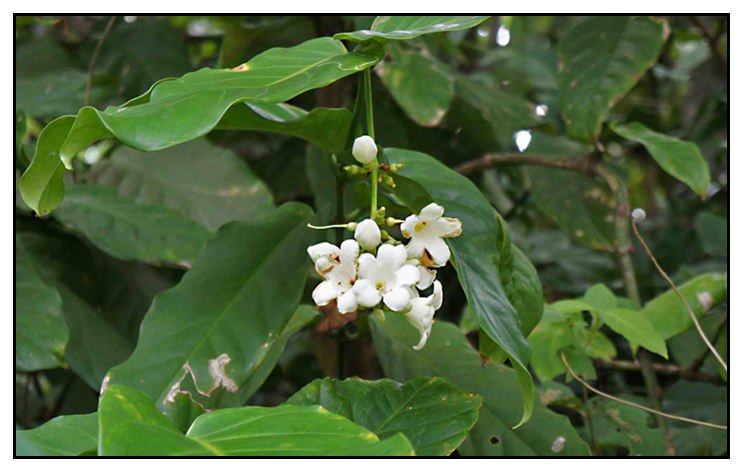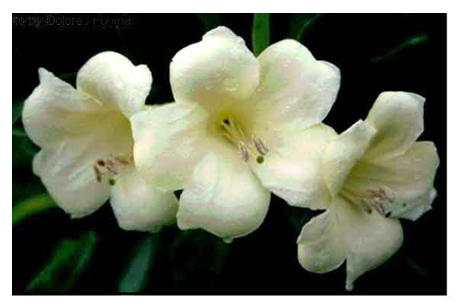 Botany Botany
Kabal is a tree growing about 6 meters or more in height. Leaves are opposite, very leathery, oblong ovate or ovate, 15 to 33 centimeters in length, 8 to 18 centimeters in width, rounded or somewhat heart-shaped at the base, and pointed at the tip. Stipules form a cup around the stem on which the leaves are borne. Flowers are borne in clusters on terminal inflorescences which are often 20 to 30 centimeters in length. Corolla is white, funnel-shaped, about 2.5 to 3 centimeters in diameter, with 5 prominent lobes. Fruit is a broadly ovoid or rounded berry, about 1 centimeter in diameter, containing many seeds and borne in good sized bunches.
 Distribution Distribution
- In primary forests at low and medium altitudes.
- Common in Bulacan, Rizal, Laguna, Quezon, Camarines, Albay, and Sorsogon Provinces in Luzon; and in Mindanao, Palawan, Balabac, Polilo, Biliran, Samar, Sibuyan, Leyte, Panay, Negros, Cebu, Bohol, Mindanao and Basilan.
- Also occurs in Burma, Thailand, Cambodia, Vietnam, throughout most of the Malaysian area, to northern Australia.
Constituents
- Study isolated lignans of (+)-pinoresinol, (+)-epipinoresinol, (+)-lariciresinol and (+)-isolariciresinol together with phenols syringaldehyde and 7,8-dihydro-7-oxy-coniferyl alcohol. (See study below) (2)
- Study yield an unusual new terpene alkaloid fagraeoside. (6)
Properties
- Antidote, febrifuge, tonic.
- Studies suggest anti-inflammatory, analgesic, antioxidant, hepatoprotective properties.
Parts used
Bark, flowers, leaves, roots.
Uses
Folkloric
- In the Philippines, bark and flowers are used as antidote for snake bites.
- Decoction of roots used as tonic after fever, for pains in the loins, and for coughs.
- Compound of decoction of leaves with santol leaves (Sandoricum koetjape), drunk as a tonic.
- Pounded roots used for poulticing ulcerations in the nose.
- Decoction of leaves used as medicinal bath for fevers in children.
- Boiled leaves used for dropsy.
- Leaf fomentation used for rheumatism.
- Bark used as application for pains associated with miscarriages.
- In India, root-bark used as febrifuge.
- In Malaysia, preparation of fresh roots used to relieve pain.
- In Malaya, roots used as tonic after fevers.
Others
- Fuel: Wood used as firewood.
- Timber: Used for general construction and combs. (4)
- Wood tar used to blacken teeth.
- In Papua New Guinea, leaves used for sealing ovens and for wrapping food. (4)
- Used as live fence.
Studies
• Fagraeoside / Anti-Inflammatory: Study of stem bark isolated a new terpene alkaloid, fagraeoside, along with secologanoside. Fagraeoside inhibited the production of PGE2 (prostaglandin E2) in murine fibroblasts. It also showed low to moderate activity in anti-acetylcholinesterase screening. (1)
• Analgesic / Vasorelaxant: Study showed relaxation effect on norepinephrine (NE)-induced contraction in rat aortic strips. The lignan (+)-pinoresinol showed dose-dependent analgesic effect on writhing symptoms in mice. (2)
• Hepatoprotective / Antioxidant / Leaves: Study evaluated the hepatoprotective ability of F. racemosa methanolic leaf extract against CCl4-induced hepatotoxicity. Results showed FR leaves methanolic extract can protect the liver from free radicals generated by CCl4. (5)
Availability
Wild-crafted.
|

![]()





